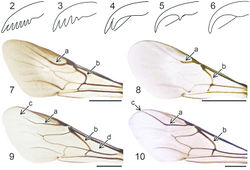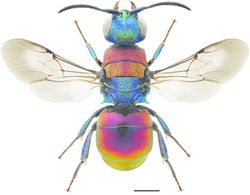Hedychrum nobile\according to Paukkunen et al 2015
| Notice: | This page is derived from the original publication listed below, whose author(s) should always be credited. Further contributors may edit and improve the content of this page and, consequently, need to be credited as well (see page history). Any assessment of factual correctness requires a careful review of the original article as well as of subsequent contributions.
If you are uncertain whether your planned contribution is correct or not, we suggest that you use the associated discussion page instead of editing the page directly. This page should be cited as follows (rationale):
Citation formats to copy and paste
BibTeX: @article{Paukkunen2015ZooKeys, RIS/ Endnote: TY - JOUR Wikipedia/ Citizendium: <ref name="Paukkunen2015ZooKeys">{{Citation See also the citation download page at the journal. |
Ordo: Hymenoptera
Familia: Chrysididae
Genus: Hedychrum
Name
Hedychrum nobile (Scopoli, 1763) – Wikispecies link – Pensoft Profile
- Sphex nobilis Scopoli, 1763: 297.
- Chrysis lucidula Fabricius, 1775: 358.
- Chrysis regia Fabricius, 1793: 243.
- Hedychrum nobile: Mocsáry 1889[1]: 172.
Diagnosis
Length 6–10 mm. The male and female are differently coloured. In the male, the head and mesosoma are completely green-blue and the metasoma is golden red (rarely greenish golden). In the female, the pronotum and mesoscutum are bright red (as in Fig. 53) or golden yellow, whereas the rest of the body has similar colouration as in the male. The pubescence is dark brown in both sexes. The species is easily confused with Hedychrum niemelai, but the mesotibial groove of the male is shallower and narrower, often indistinct (Fig. 57), and the female has a broader, apically undivided, tubercle on S3 (Fig. 59). Punctation of T3 is also sparser in both sexes, especially in the male (Fig. 62).
Distribution
Denmark, Estonia, Finland, Latvia, Lithuania, Norway, Sweden. Very common. – Trans-Palearctic: from Europe to Siberia (Linsenmaier 1959[2]).
Biology
Habitat: sparsely vegetated sandy areas, dunes. Adults are often found on flowers of Apiaceae, Asteraceae, Euphorbiaceae, Onagraceae and Rosaceae (Kusdas 1956[3], Brechtel 1985[4], Rosa 2004[5], our own obs.). Flight period: June to August. Host: Cerceris arenaria (Linnaeus) (Crabronidae) (Alfken 1915[6], Lomholdt 1975[7], Petit 1975[8], Schmid-Egger et al. 1995[9], Saure 1998[10], our own obs.), possibly also Cerceris quadrifasciata (Panzer) and Cerceris rybyensis (Linnaeus) (Alfken 1915[6], Lomholdt 1975[7]).
Taxon Treatment
- Paukkunen, J; Berg, A; Soon, V; Ødegaard, F; Rosa, P; 2015: An illustrated key to the cuckoo wasps (Hymenoptera, Chrysididae) of the Nordic and Baltic countries, with description of a new species ZooKeys, (548): 1-116. doi
Images
|
Other References
- ↑ Mocsáry A (1889) Monographia Chrysididarum orbis terrarium universi. Musæi Nat. Hungarici Adiuncto, Academiæ Scientiarum Hungaricæ Socio. Typis Societatis Franklinianæ, Budapest, 643 pp.
- ↑ Linsenmaier W (1959) Revision der Familie Chrysididae (Hymenoptera) mit besonderer Brücksichtigung der europäischen Spezies. Mitteilungen der Schweizerischen Entomologischen Gesellschaft 32: 1–232.
- ↑ Kusdas K (1956) Beitrag zur Kenntnis der Goldwespenfauna (Chrysididae und Cleptidae) Oberösterreichs, unter besonderer Berücksichtigung des Grossraumes von Linz. 2. Nachtrag. Naturkundliches Jahrbuch der Stadt Linz 1956: 307–326.
- ↑ Brechtel F (1985) Naturschutzbezogene Erfassung der Stechimmenfauna des Bienwaldes und seiner Randbereiche (Südpfalz) unter besonderer Berücksichtigung der Ökologie Kunstnest-bewohnender Arten. Diss. Univ., Karlsruhe, 437 pp.
- ↑ Rosa P (2004) Alcune osservazioni sulle relazioni tra Vegetazione e Crisidi (Hymenoptera, Chrysididae) in Italia. Giornale Italiano di Entomologia 11: 79–90.
- ↑ 6.0 6.1 Alfken J (1915) Verzeichnis der Goldwespen (Chrysiden) Nordwestdeutschlands. Abhandlungen herausgegeben vom Naturwissenschaftlchen Verein zu Bremen 23: 291–295.
- ↑ 7.0 7.1 Lomholdt O (1975–1976) The Sphecidae (Hymenoptera) of Fennoscandia and Denmark. Fauna Entomologica Scandinavica 4: 1–452.
- ↑ Petit J (1975) Les Chrysides de la faune Belge (Hymenoptera Chrysididae). Notes faunistiques et ethologiques. 3. Révue verviétoise d’Histoire Naturelle 32: 58–63.
- ↑ Schmid-Egger C, Risch S, Niehuis O (1995) Die Wildbienen und Wespen von Rheinland-Pfalz (Hymenoptera, Aculeata) – Verbreitung, Ökologie und Gefährdungssituation. Fauna und Flora in Rheinland-Pfalz, Beiheft 16: 1–296.
- ↑ Saure C (1998) Beobachtungen und Anmerkungen zur Wirtsbindung einiger Goldwespenarten im nordostdeutschen Raum (Hymenoptera: Chrysidididae: Chrysidinae). Bembix 10: 15–18.


